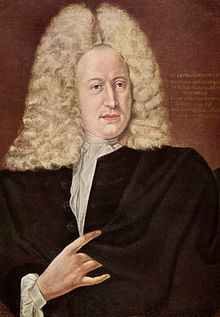Johann Georg Liebknecht
Johann Georg Liebknecht (born April 23, 1679 in Wasungen , Thuringia; † September 17, 1749 in Gießen ) was professor of mathematics (1707–1737) and theology (since 1721) at the Ludoviciana and superintendent in Gießen.
Life
Last but not least, Liebknecht was appointed to the small state university in Giessen on the recommendation of Gottfried Wilhelm Leibniz , because he was versatile and could teach several subjects competently. He was both a recognized Protestant theologian and a leading mathematician. Other focal points of his work were the application of mathematics in the military (artillery, fortress construction), geology (mineral deposits), antiquity (excavations of burial mounds near Gießen), fossils and astronomy. Like other Protestant theologians, he avoided making a statement about the heliocentric worldview even 200 years after Copernicus.
He was in contact with famous scientists like Gottfried Wilhelm Leibniz. Since 1715 he was a member of the Leopoldina and since 1716 he belonged to the Royal Prussian Society of Sciences . In 1728 he was elected a "Fellow of the Royal Society ".
Like all rectors of the university, he was portrayed. This portrait is part of the " Giessen Professors Gallery ".
Sidus Ludoviciana
Liebknecht was an avid astronomer. He made some of the rare northern lights observations in the period 1711 to 1721, i.e. in the outgoing Maunder minimum . With another observation, however, he has not achieved a sheet of fame. On December 2, 1722, he observed a faint star in the telescope and believed to see a relative movement ( proper movement ) to the neighboring stars of the Big Dipper, Mizar and Alkor . He named the supposed new planet Sidus Ludoviciana . Liebknecht had overlooked, however, that this star had already been observed by Benedetto Castelli in 1616 at the same star location , so it could not be a planet.
Origin and descendants
According to an old family tradition, Martin Luther is said to be one of the ancestors, but this cannot be documented in a document. His great-grandson Wilhelm Liebknecht , one of the founding fathers of the SPD , also mentioned this parentage when he was asked about his relationship to religion.
Johann Georg Liebknecht is the ancestor of Wilhelm , Karl , Theodor , Otto , Robert and Kurt Liebknecht . He had 21 children from two marriages. Wilhelm Liebknecht's sons (best known Theodor, Karl and Otto) and his grandsons (best known Robert and Kurt) are related to Johann Georg twice: Wilhelm is a descendant from the 2nd marriage (1720) with the doctor's daughter Regine Sophie Hoffmann ( 1698–1778) and Wilhelm's second wife Natalie Reh (1835–1909) is a great-granddaughter of Johann Georg from his first marriage (1707) with the doctor's daughter Katharina Elisabeth Elwert (1686–1719).
Fonts
- Basic principles of the common today, and all mathematical sciences and teachings most necessary in war and civil operations, including the artillery, Architectura Militaris and Civilis (...) . Frankfurt and Leipzig, EH Lammers 1726.
- Hassiae subterraneae specimen clarissima testimonia diluvii universalis ... exhibens. Cui accedit: I. Joan. Geilfusii de terra sigillata Laubacensi ... II. De serratis et bigatis numis dissertatio epistolica (JG Liebknecht) qua antiqua Wetteravia illustratur ad locum Tac. de MG cap. V. - Gissae 1730
- D. Io. Georgii Liebknecht ... Uberior stellae Ludovicianae noviter detectae, etc , Gissae, 1723; 16 p; 4to
- Yo. Georg Liebknecht praes. Frid. Wilhelm Marquard resp. Dissertatio cosmographica de Harmonia corporum mundi totalium nova ratione in numeris parfectis generatim definitia. , Giessen 1718
literature
- Johann Christian Poggendorff : Biographical-literary concise dictionary of the exact natural sciences.
- Peter Moraw : Brief History of the University of Giessen. Giessen 1990, ISBN 3-927835-00-5 .
- Friedrich Wilhelm Weitershaus: The Liebknechts. A Thuringian-Hessian family of officials , in: Mitteilungen des Oberhessischen Geschichtsverein 60 (1975), pp. 95-143 full text
Web links
- Historical Northern Lights observations (French) ( Memento from September 29, 2007 in the Internet Archive )
| personal data | |
|---|---|
| SURNAME | Liebknecht, Johann Georg |
| BRIEF DESCRIPTION | German mathematician and theologian, professor of theology and mathematics |
| DATE OF BIRTH | April 23, 1679 |
| PLACE OF BIRTH | Wasungen |
| DATE OF DEATH | September 17, 1749 |
| Place of death | to water |
